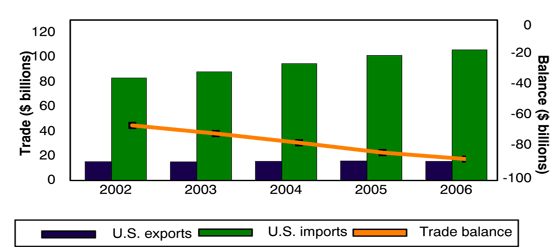View Section in Publication :: Return to Overview
Exports, Imports and Trade Balance

Key Trends
- The growth of the trade deficit in textiles and apparel in 2006 principally stemmed from the growth of imports from Asia, particularly China, that occurred when quotas were eliminated in 2005.
- The small increase in U.S. exports of textiles and apparel is largely attributable to the relatively weak U.S. dollar. The most important U.S. exports of textile and apparel products were fabric, fibers, and yarn, which are used to make finished apparel products.
- Mexico and Canada are the largest individual country markets for U.S.-made textiles and apparel as a result of their relative proximity, which reduces shipping costs and transit time. The United States had a positive trade balance with both countries in 2006.
- U.S. imports of textiles and apparel increased by 4 percent to $104.6 billion, with Asian countries accounting for two thirds of total imports. The increase in imports reflected the continued effects of the elimination of quotas in 2005 as required under the WTO Agreement on Textiles and Clothing (ATC).
- China was the largest supplier by far with 30 percent of sector imports. Much of the growth in China's shipments was concentrated in cotton apparel. Significant growth also occurred in China's shipments of wool apparel, especially wool sweaters.
Trade Shifts in 2006 from 2005
- U.S. trade deficit: Increased $3.9 billion (5 percent) to $86.5 billion
- U.S. exports: Increased $224 million (1 percent) to $18.1 billion
- U.S. imports: Increased $4.1 billion (4 percent) to $104.6 billion
- U.S. trade deficit: Increased $1.1 billion (7 percent) to $18.5 billion
- U.S. exports: Increased $66 million (13 percent) to $573 million
- U.S. imports: Increased $1.2 billion (7 percent) to $19.0 billion
Other Government Resources
International Trade Administration Office of Textiles and Apparel
